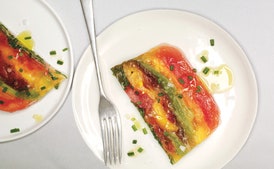
Introduction
The Tomato Terrine stands as a testament to the versatility of tomatoes, transforming them into a delectable and visually appealing dish. This recipe is not only a celebration of fresh ingredients but also an innovative approach to traditional cuisine that highlights the simplicity yet depth of flavors in each layer.
Tips for this Recipe
To achieve the perfect Tomato Terrine, ensure all tomatoes are peeled uniformly and consider experimenting with different types and colors to enhance both taste and visual appeal. Precise measurements of ingredients contribute significantly to the balance of flavors, making the use of a digital scale highly recommended for those aiming for culinary excellence.
Why you will love this recipe
The Tomato Terrine is more than just an appetizing dish; it’s a sensory journey that marries textures and flavors into one cohesive experience. Its layered design invites diners to indulge in the complexity of each ingredient, while its elegant presentation makes for a perfect centerpiece at any meal.
Ingredients
2 carrots, chopped
– 1 leek, thinly sliced
– 1 celery stalk, chopped
– 1 shallot, halved
– 1 garlic clove
– 10 flat-leaf parsley sprigs
– 10 black peppercorns
– 3 fresh bay leaves (or 1 dried)
6 pounds large firm ripe tomatoes, peeled
– 1 teaspoon kosher salt plus more for seasoning
– 1 1/2 tablespoons unflavored gelatin
– 1/4 cup thinly sliced chives
– 2 teaspoons red wine vinegar
Nonstick vegetable oil spray, extra-virgin olive oil, sea salt
Adviced equipments
For crafting this culinary delight, the following equipment is advised:
– Food Processor: Essential for creating a smooth puree base from tomatoes and herbs.
– Blender (optional): Useful if you don’t have access to a food processor; less efficient but effective with smaller quantities.
– Silicone Spatula: Ideal for mixing and scraping ingredients into molds without causing damage.
– Rubber Spatula: Suitable for combining all elements, especially when making layered terrines.
– Digital Scale: Provides precise measurement of dry ingredients, crucial for a balanced flavor profile in your tomato terrine.
– Measuring Cups and Spoons: Accurate tools for measuring out any required dry components, enhancing the dish’s overall success.
– Parchment Paper Sheets or Silicone Molds: Necessary to line molds with puree, ensuring hassle-free removal of the terrine after it has set and shaped properly.
– Chef’s Knife & Cutting Board: Required for prepping vegetables like herbs and potential additional veggies that complement the dish before assembly. These tools are fundamental to maintaining a clean, efficient cooking process.
History of the recipe
The conceptualization of Tomato Terrine can be traced back to various culinary traditions where layered dishes hold historical significance in gastronomy. While its current form may seem modern, it reflects a longstanding appreciation for layering flavors and textures, much like the artful stacking seen in classic terrines and mousses of yesteryears.
fun facts about this recipe
Apart from its rich historical roots, the Tomato Terrine brings forth fun elements that resonate with today’s food enthusiasts. Its unique combination of simple yet robust ingredients allows for endless experimentation and personalization, whether it be through different herb choices or tomato varieties. Moreover, as a dish primarily composed of fresh produce, it also serves as an environmentally conscious option in the realm of gourmet cooking. The versatility to present this terrine not only on the plate but perhaps even layered with other ingredients opens up a playful and creative space for home cooks to explore their culinary boundaries.



